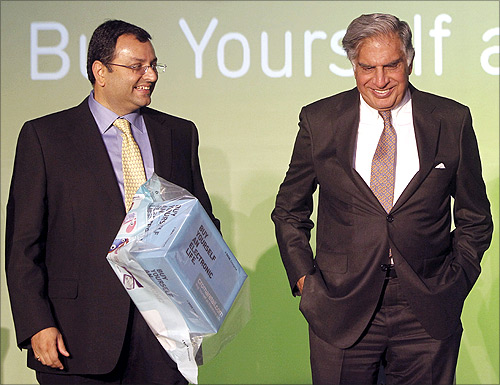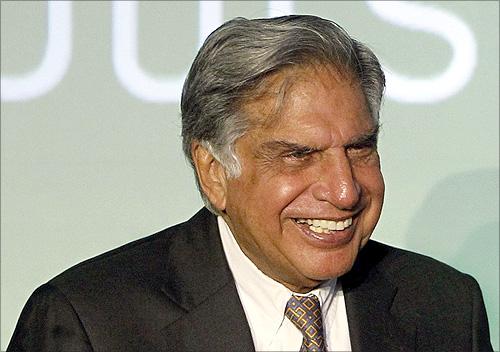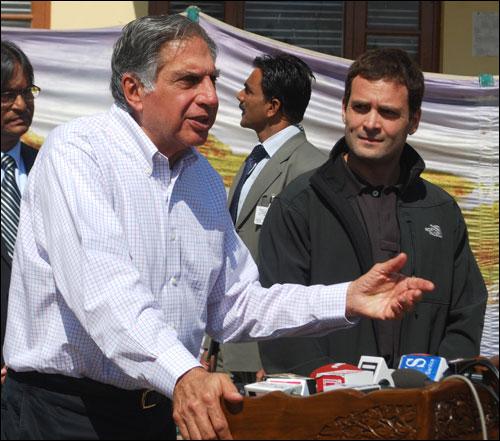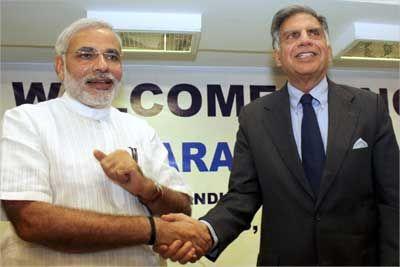 | « Back to article | Print this article |
What makes Ratan Tata a super achiever
Think back to 1991. The 87-year-old J R D Tata had been Tata chairman for more than half a century.
With the group's leading companies managed by similarly ageing satraps, the last thing the Tata name stood for was vibrancy and energy; the more usual adjectives were staid and unenterprising.
That was when a relatively young Ratan Tata (53) was named the new group chairman, provoking questions about his track record (undistinguished) and therefore capability, quite apart from acceptability.
Click NEXT to read more...
Ta-Ta, Ratan: An iconic Indian
What makes Ratan Tata a super achiever
Those questions got answered long ago, though acceptability was acquired only by hoofing out some superannuated recalcitrants.
Two decades later, as a 75-year-old Ratan Tata prepares to step down today, the Tata brand stands for vibrancy and energy, innovation and even daring (pace its over-the-top bids for overseas assets), and still doing business the Tata way.
Equally important, as Mr Tata hands over the reins to 44-year-old Cyrus Mistry, most group company CEOs are men (yes, no women unfortunately) in their 40s, with the companies themselves held together more tightly through shareholding and brand discipline.
Click NEXT to read more...
What makes Ratan Tata a super achiever
As Rahul Bajaj said, Ratan Tata has changed the group's DNA - almost entirely for the better.
The group itself is 18 times bigger than in 1991, if counted in US dollars; in rupees, it is 51 times bigger, and compares well with the rest of corporate India, which it dominates in all rankings.
The growth numbers for profits are similarly impressive. Both have been helped by the stellar performance of Tata Consultancy Services (TCS), which remains the country's largest software services firm.
TCS also bankrolled much of the increased intra-group shareholding and asset acquisition drives. But even without TCS, the group's performance under Ratan Tata has been impressive, though growth in market capitalisation (without TCS, which was listed only in 2004) has been below par at an annual rate of 10.8 per cent.
Click NEXT to read more...
What makes Ratan Tata a super achiever
The return on capital employed too has taken a dip, from 15.2 per cent in 1992 to 14.4 per cent even with TCS - reflecting the under-performance of some of the overseas assets, and the fact that an on-again-off-again Tata Motors has by far the lowest price-earnings multiple in the auto industry.
It is also important to note the personal dignity with which Ratan Tata has conducted himself throughout these two dynamic and often tumultuous decades, and to recognise that he long ago became the doyen of Indian industry.
Elegantly attired, and moving at ease among the world's business leaders, Mr Tata has also acquired global standing for himself and his group - becoming, for instance, the largest private employer in the UK.
Click NEXT to read more...
What makes Ratan Tata a super achiever
Some would question his endorsement of Narendra Modi when the Tata Nano project moved to Gujarat, others would point to the scandal at Tata Finance (led at the time by someone who had worked closely with Mr Tata), and many will remember Niira Radia and her desperate attempts to influence the choice of telecom minister in 2009.
Mr Tata has also had his run-ins with the media, more than once denying words attributed to him, being excessively sensitive about criticism, and blacklisting one large media house after the other when it came to group advertising.
But these are minor aspects of an illustrious business career that in the end has more than vindicated JRD's choice of successor in 1991, and which leaves the Tata name shining brighter than the others.





